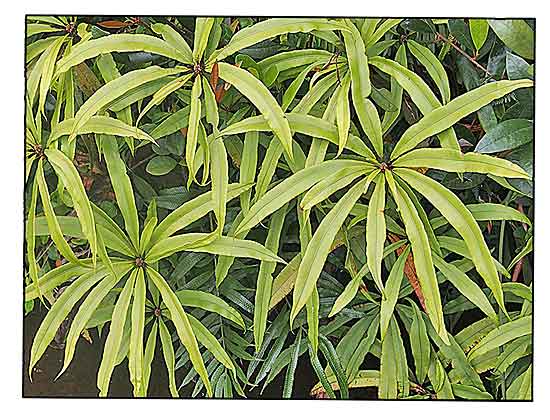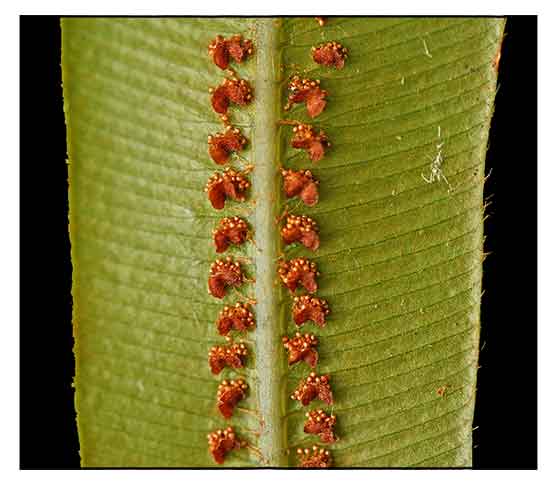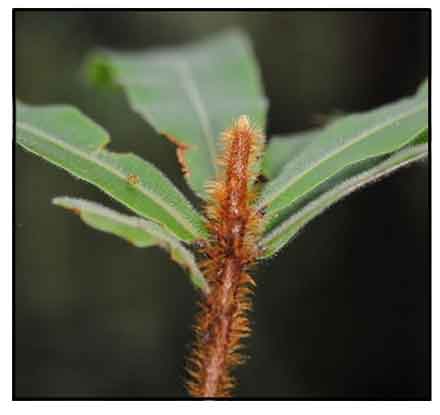
Family •Polypodiaceae / Oleandraceae
Kaliskis-ahas
Oleandra neriiformis Cav.
SNAKE SKIN FERN
Lun ye tiao jue
| Scientific names | Common names |
| Aspidium bantamense Blume | Kaliskis-ahas (Tag.) |
| Aspidium micranthum Blume | Lunas (Tag.) |
| Aspidium neriiforme (Cav.) Sw. | Snake skin fern (Engl.) |
| Aspidium phyllarthron Kunze | Stilt fern (Engl.) |
| Aspidium salaccense Blume | |
| Blechnum colubrinum Blanco | |
| Oleandra archboldii Copel. | |
| Oleandra bantamensis (Blume) Kunze | |
| Oleandra christophersenii C.Chr. | |
| Oleandra ciliata Klotzsch | |
| Oleandra cllemensiae Copel. | |
| Oleandra colubrina (Blanco) Copel. | |
| Oleandra colubrina var. membranacea Copel. | |
| Oleandra colubrina var. nitida Copel. | |
| Oleandra cuspidata Baker | |
| Oleandra herrei Copel. | |
| Oleandra hirta Brack. | |
| Oleandra hirtella Miq. | |
| Oleandra micrantha (Blume) Kunze | |
| Oleandra mollis C.Presl | |
| Oleandra neriiformis Cav. | |
| Oleandra neriiformis var. hirta (Brack.) Baker | |
| Oleandra nitida (Copel.) Copel. | |
| Oleandra oblanceolata Copel. | |
| Oleandra parksii Copel. | |
| Oleandra phyllarthron (Kunze) C.Presl | |
| Oleandra platybasis Copel. | |
| Oleandra samoensis Gand. | |
| Oleandra subdimorpha Copel. | |
| Ophiopteris verticillata Reinw. | |
| Oleandra neriiformis Cav. is an accepted species. KEW: Plants of the World Online | |
| Other vernacular names |
| CHINA: Lun ye tiao ju. |
| INDONESIA: Paku areuy, Paku korani, Paku sake. |
| THAILAND: Nakkharat, Phaya ngu, Nakho. |
Updated October 2023 / November 2012
![]()
 |
| PHOTOS / ILLUSTRATIONS |
| IMAGE SOURCE: Oleandracea : Oleandra neriiformis / Living plant / Copyright © 2022 Wendy A Mustaqim (contact: [email protected]) [ref. DOL205699] / Non-Commercial Use / click on image or link to go to source page / Phytoimages.siu.edu |
| OTHER IMAGE SOURCE: Oleandracea : Oleandra neriiformis / Lower (abaxial) lamina showing sori / Copyright © 2013 Julie F Barcelona (contact: [email protected]) [ref. DOL74928] / Non-Commercial Use / click on image or link to go to source page / Phytoimages.siu.edu |
| OTHER IMAGE SOURCE: Oleandra neriiformis / Copyright © Michael Sundae / / Non-Commercial Use / click on image or link to go to source page / FERNS and LYCOPHYTES of the WORLD |
Additional
Sources and Suggested Readings |
• |
DOI: It is not uncommon for links on studies/sources to change. Copying and pasting the information on the search window or using the DOI (if available) will often redirect to the new link page. (Citing and Using a (DOI) Digital Object Identifier) |
| List of Understudied Philippine Medicinal Plants |
| New plant names needed The compilation now numbers over 1,300 medicinal plants. While I believe there are hundreds more that can be added to the collection, they are becoming more difficult to find. If you have a plant to suggest for inclusion, please email the info: local plant name (if known), any known folkloric medicinal use, scientific name (most helpful), and, when possible, a photo. Your help will be greatly appreciated. |
 |
• |

 Gen info
Gen info - A terrestrial thicket-forming fern, up to 2 m tall, with a branching shrublike habit, easily mistaken for a flowering plant, sometimes climbing-epiphytic. Rhizome stiff, erect or suberect, up to 10 mm in diameter, acting as an aerial stem, densely covered with scales; scales appressed, imbricating, the peltate basal part 1-1.5 mm wide, dark brown to black, narrowed abruptly into the up to 3.5 mm long apical part which is ciliate when young; aerial stem branched, straight, 1-1.5(-2) m tall, with few or no rhizophores, the leaves close together in pseudowhorls of 4-14, the whorls separated by 2-10 cm long internodes. Leaves simple, clustered, more or less coriaceous, on 2-5 mm long phyllopodia borne on all sides of the aerial stem; petiole 0.5-10 mm long, scaly; lamina oblanceolate, up to 40 cm × 3.5(-7.5) cm but often narrower, base attenuate, margins entire, apex caudate-acuminate, midrib scaly when young, glabrous or pilose; veins close together, simple or once forked, straight, at a broad angle to the midrib. Sori in one irregular row on each side of the midrib, usually 0-3 mm from the midrib; indusium reniform, up to 2 mm wide. Spores monolete, ellipsoid to spheroid, with irregularly toothed wings. (
- A terrestrial thicket-forming fern, up to 2 m tall, with a branching shrublike habit, easily mistaken for a flowering plant, sometimes climbing-epiphytic. Rhizome stiff, erect or suberect, up to 10 mm in diameter, acting as an aerial stem, densely covered with scales; scales appressed, imbricating, the peltate basal part 1-1.5 mm wide, dark brown to black, narrowed abruptly into the up to 3.5 mm long apical part which is ciliate when young; aerial stem branched, straight, 1-1.5(-2) m tall, with few or no rhizophores, the leaves close together in pseudowhorls of 4-14, the whorls separated by 2-10 cm long internodes. Leaves simple, clustered, more or less coriaceous, on 2-5 mm long phyllopodia borne on all sides of the aerial stem; petiole 0.5-10 mm long, scaly; lamina oblanceolate, up to 40 cm × 3.5(-7.5) cm but often narrower, base attenuate, margins entire, apex caudate-acuminate, midrib scaly when young, glabrous or pilose; veins close together, simple or once forked, straight, at a broad angle to the midrib. Sori in one irregular row on each side of the midrib, usually 0-3 mm from the midrib; indusium reniform, up to 2 mm wide. Spores monolete, ellipsoid to spheroid, with irregularly toothed wings. (
